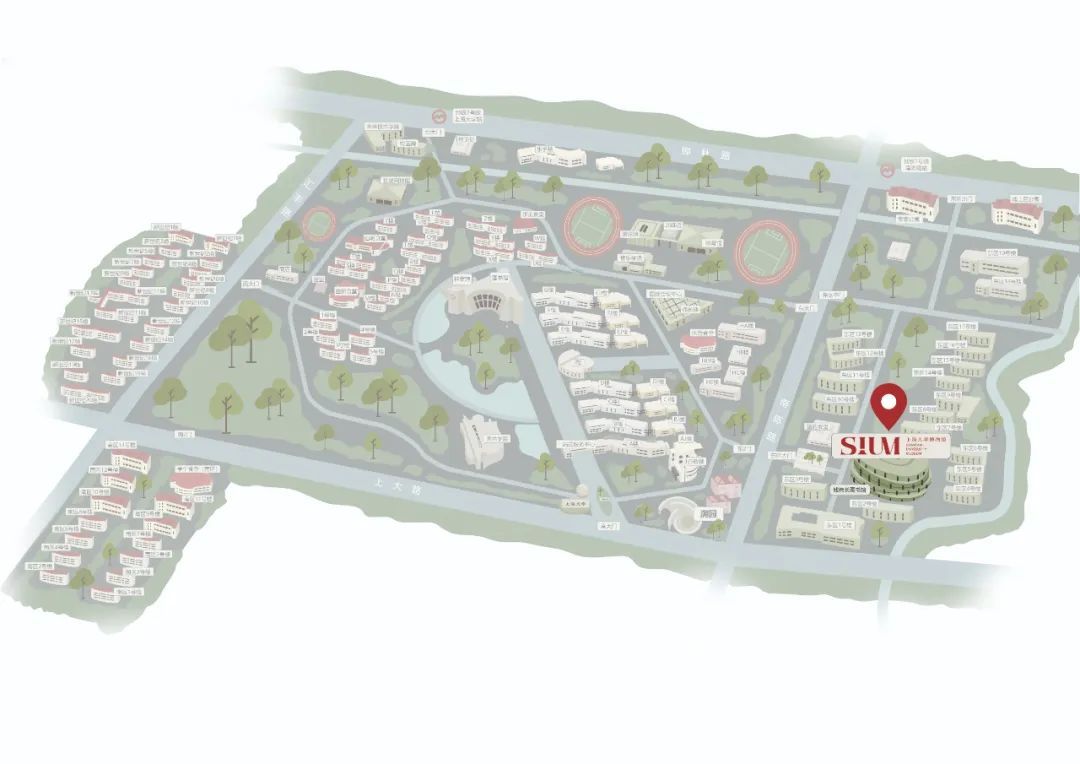· 商代后期(公元前1300年—前1100年)
· 高34厘米,横径20.5厘米,纵径18.5厘米
· 2022年出土于四川广汉三星堆遗址八号祭祀坑,K8⑨:684
· 四川省文物考古研究院藏
· Late Shang Dynasty (1300B.C. - 1100B.C.)
· H.34cm; Horiz Dia.20.5cm; Vert Dia.18.5cm
· Unearthed from No. 8 sacrificial pit at the Sanxingdui Site in Guanghan, Sichuan, in 2022,K8⑨:684
Collection of Sichuan Provincial Cultural Relics and Archaeology Research Institute
圆顶笄发,头顶浑圆,头发与面部界限分明。长脸宽颐,脸庞瘦削,宽眉大眼,眼角上挑,颧骨略凸,蒜头鼻,鼻翼较宽,阔口紧闭,嘴角下勾,神情肃穆。大耳外张,耳廓饰有卷云纹,耳垂各有一穿孔,可能用于悬挂耳环之类的装饰品。颈较粗,颈下端前呈倒尖角形,后呈圆弧形。头顶后方有一方孔,其下有“U”形轮廓。
该造型的青铜人头像与平顶辫发造型的青铜人头像风格迥异,它们与立发、高冠等青铜人头像,共同构成了古蜀文明不同地位、不同阶层的人在祭祀场景中的群像。
The bronze head has a round top and clear hairlines, with hair coiled up with a Ji (笄, hairpin). It has a long face, a wide cheek, slender cheeks, thick eyebrows, large eyes with upward slanting corners, prominent cheekbones, a bulbous nose with a wide nasal wing, and a tightly closed large mouth with hooked corners, showing a solemn expression. The ears are large and spread outward, decorated with Juanyun Wen (卷云纹,curling-cloud pattern) on the outer part. There is a perforation on each earlobe, possibly for hanging earrings or other ornaments. The neck is relatively thick. Its front part has an inverted triangular edge, while its back part has a circular edge. There is a hole at the back of the head.
The style of this bronze human-head statue differs significantly from that with flat-top braided bronze human head. Bronze human-head statues of various styles, including those with towering hair and high crown, represent different social statuses and classes in the sacrificial scenes of the ancient Shu civilization.
克劳德·洛兰头像

· 奥古斯都·罗丹(1840—1917)
· 青铜
· 高40厘米,宽35厘米,深32.5厘米
· Auguste Rodin (1840-1917)
· Bronze
· H.40cm; W.35cm; Pr.32.5cm
在1888年,奥古斯都·罗丹接受了南希市委托,开始为著名古典风景画家克劳德·热莱(Claude Gellée,1600—1682)设计一座纪念雕像。克劳德·热莱更为人熟知的名字是克劳德·洛兰(Claude Lorrain),以其卓越的风景画技艺而著名,尤其擅长描绘大自然景观,如河流、山脉和日落等。
他的作品通常呈现柔和的色彩和浪漫主义的氛围,被认为是巴洛克时期最伟大的风景画家之一。为了这个纪念雕像,罗丹投入了数年的创作时间。他像往常一样,首先进行了裸体人物形象的研究,然后才着手创作整体雕像,先雕刻出人体不同部位的雕塑,再将这些雕塑铸成青铜件。例如,在这里展出的真人大小头像,头部呈现出17世纪男性典型的发型,稍微偏向左侧。这个头像本身是在1890年至1891年期间创作的,后来由罗丹博物馆委托E.Godard浇铸厂制成青铜版本,使用失蜡法技艺。在人物的脖子处,可以看到A.Rodin的签名,而左肩上带有浇铸厂的标记E.Godard Fondr。
这个纪念雕像的创作充分展示了罗丹的独特艺术风格,他以极致的技艺和对细节的关注,塑造出了生动而富有表现力的人物形象。这个作品也反映了罗丹对艺术家克劳德·热莱的深刻理解,以及他对自然和人类形象的深刻洞察力。
In 1888, commissioned by the city of Nancy (Meurthe et Moselle), Rodin started the design of a memorial statue for Claude Gelée. Also known as Claude Lorrain (1600-1682), Claude Gelée was celebrated for his exceptional landscape painting skills, particularly his depiction of natural landscape such as rivers, mountains, and sunsets. His works are usually imbued with gentle colors amid a romantic atmosphere, and he was hailed as one of the greatest landscape painters of the Baroque period.
Rodin devoted several years to the creation of this memorial statue. As he did for other works, Rodin researched nude figures before sculpting the overall work. He sculpted different body parts and had them cast into bronze pieces. For example, this life-sized head exhibits slightly tilting to the left showcase a typical hairstyle of males living in the 17th century. It was created in 1890-1891, and was later cast into a bronze sculpture by Godard Foundry under the commission of Rodin Museum with the lost-wax method. Rodin’s signature, “A. Rodin”, was cast on the neck, and the foundry’s name, “E. Godard Fondr”, was on the left shoulder.
Rodin fully displayed his unique artistic style in this memorial statue. By exerting his techniques to the extreme and focusing on details, he eventually created this lifelike and expressive statue that reflected his in-depth understanding of the artist Claude Gelée and his keen insight into nature and human figures.
展览时间:
2023年12月13日至2024年2月1日
展览地点:
上海大学博物馆一层临展厅
(上海市宝山区南陈路333号)
开放时间:
周一至周日8:30-16:30(16:00停止入馆)
校内师生凭本人一卡通入馆,无需预约。
校外观众采取网上预约方式入馆,扫描下方二维码或关注“上海大学博物馆”微信公众号,点击“个人预约”。

/地址/
上海大学博物馆
(南陈路333号)


